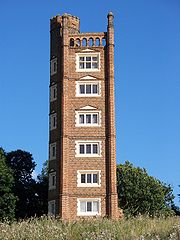
Freston Tower
Encyclopedia

Folly
In architecture, a folly is a building constructed primarily for decoration, but either suggesting by its appearance some other purpose, or merely so extravagant that it transcends the normal range of garden ornaments or other class of building to which it belongs...
south of Ipswich
Ipswich
Ipswich is a large town and a non-metropolitan district. It is the county town of Suffolk, England. Ipswich is located on the estuary of the River Orwell...
, Suffolk
Suffolk
Suffolk is a non-metropolitan county of historic origin in East Anglia, England. It has borders with Norfolk to the north, Cambridgeshire to the west and Essex to the south. The North Sea lies to the east...
in the village of Freston
Freston, Suffolk
Freston is a village and a civil parish in the Babergh District, in the English county of Suffolk.-History:Freston is notable as the location of the last outbreak of bubonic plague in England. The centre of the outbreak was Latimer Cottages, where it is thought plague-bearing rats may have come...
. It stands on the banks of the River Orwell
River Orwell
The River Orwell flows through the county of Suffolk in England. Its source river, above the tidal limit at Stoke Bridge, is known as the River Gipping. It broadens into an estuary at Ipswich where the Ipswich dock has operated since the 7th century and then flows into the North Sea at Felixstowe...
.
Construction date
Arguably the oldest folly in EnglandEngland
England is a country that is part of the United Kingdom. It shares land borders with Scotland to the north and Wales to the west; the Irish Sea is to the north west, the Celtic Sea to the south west, with the North Sea to the east and the English Channel to the south separating it from continental...
, the tower has various claims for construction dates, ranging from the 15th to 17th centuries.
There is a legend that the tower was built by "Lord de Freston" in the 15th century for his daughter Ellen, so she could study a different subject on a different floor six days of the week: the first floor was dedicated to reception, the second to tapestry working, the third to music, the fourth to painting, the fifth to literature, and the sixth to astronomy, complete with instruments for taking observations. This was written about in a novel by Reverend Richard Cobbold entitled Freston Tower and so should not be taken as fact. There is much evidence against this legend, in fact, (documents referring to the construction of the tower within the twelve years preceding 1569) and it is likely that the tower was constructed by Edmond Latymer as a lookout over Freston Reach of the River Orwell
River Orwell
The River Orwell flows through the county of Suffolk in England. Its source river, above the tidal limit at Stoke Bridge, is known as the River Gipping. It broadens into an estuary at Ipswich where the Ipswich dock has operated since the 7th century and then flows into the North Sea at Felixstowe...
. There are further descriptions suggesting a construction date of 1655.
Landmark Trust
Landmark Trust
The Landmark Trust is a British building conservation charity, founded in 1965 by Sir John and Lady Smith, that rescues buildings of historic interest or architectural merit and then gives them a new life by making them available for holiday rental...
, a historical building preservation charity and the current owner of Freston Tower, suggests the tower "was built in 1578 by a wealthy Ipswich merchant called Thomas Gooding".
Uses
By 1730, the Tower was available to let, complete with furniture. Between 1772 and 1779, Freston Tower was used for small-pox patients under inoculationInoculation
Inoculation is the placement of something that will grow or reproduce, and is most commonly used in respect of the introduction of a serum, vaccine, or antigenic substance into the body of a human or animal, especially to produce or boost immunity to a specific disease...
.
Modern Use
Most recently owned by Claire Hunt until 1999, Freston Tower was donated to the current owner Landmark TrustLandmark Trust
The Landmark Trust is a British building conservation charity, founded in 1965 by Sir John and Lady Smith, that rescues buildings of historic interest or architectural merit and then gives them a new life by making them available for holiday rental...
, a charity that rescues and restores historical buildings.
As of 2004, the tower became available to let as a holiday home.

